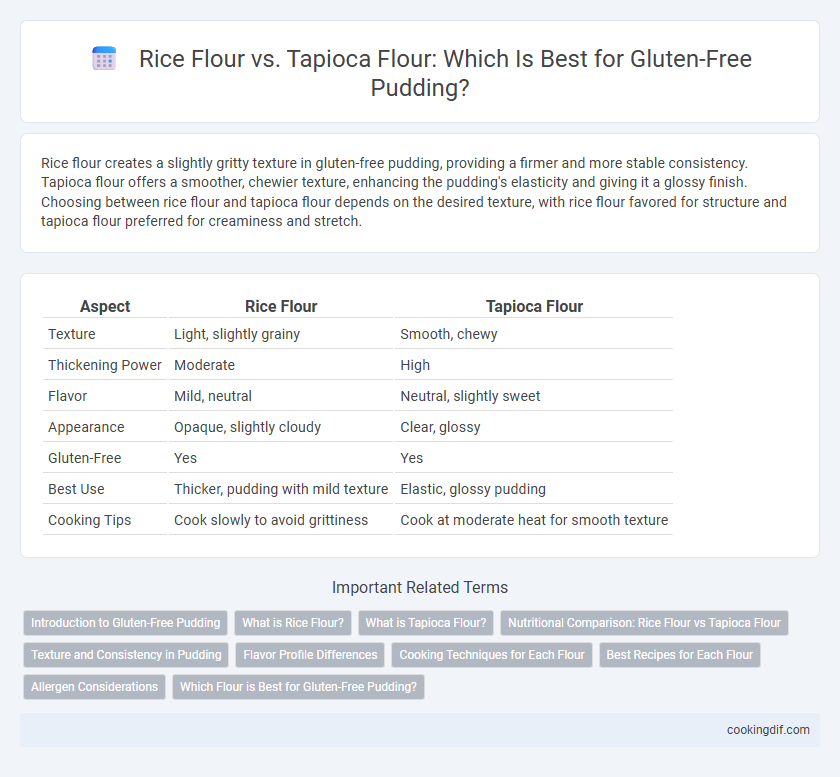Rice flour creates a slightly gritty texture in gluten-free pudding, providing a firmer and more stable consistency. Tapioca flour offers a smoother, chewier texture, enhancing the pudding's elasticity and giving it a glossy finish. Choosing between rice flour and tapioca flour depends on the desired texture, with rice flour favored for structure and tapioca flour preferred for creaminess and stretch.
Table of Comparison
| Aspect | Rice Flour | Tapioca Flour |
|---|---|---|
| Texture | Light, slightly grainy | Smooth, chewy |
| Thickening Power | Moderate | High |
| Flavor | Mild, neutral | Neutral, slightly sweet |
| Appearance | Opaque, slightly cloudy | Clear, glossy |
| Gluten-Free | Yes | Yes |
| Best Use | Thicker, pudding with mild texture | Elastic, glossy pudding |
| Cooking Tips | Cook slowly to avoid grittiness | Cook at moderate heat for smooth texture |
Introduction to Gluten-Free Pudding
Rice flour and tapioca flour are essential gluten-free ingredients that provide distinct textures to pudding. Rice flour offers a creamy, slightly grainy consistency, while tapioca flour adds a smooth, elastic quality, enhancing the pudding's firmness and chewiness. Combining both flours can create a balanced gluten-free pudding with optimal texture and flavor.
What is Rice Flour?
Rice flour, derived from finely milled white or brown rice, serves as a popular gluten-free thickening agent in pudding recipes. It offers a mild flavor and smooth texture without altering the pudding's taste, making it ideal for enhancing consistency. Compared to tapioca flour, rice flour provides a denser, less elastic finish, favoring creamy, stable puddings.
What is Tapioca Flour?
Tapioca flour, extracted from the cassava root, is a popular gluten-free starch used in pudding recipes for its excellent thickening properties and smooth texture. Unlike rice flour, which can produce a slightly grainy consistency, tapioca flour creates a creamy and stretchy pudding that holds together well. Its neutral flavor enhances the pudding's taste without overpowering other ingredients, making it ideal for gluten-free desserts.
Nutritional Comparison: Rice Flour vs Tapioca Flour
Rice flour contains higher protein and fiber levels compared to tapioca flour, making it a more nutritious option for gluten-free pudding. Tapioca flour, derived from cassava root, is primarily composed of carbohydrates with minimal protein and fiber content. Rice flour also provides essential minerals like manganese and selenium, whereas tapioca flour is lower in micronutrients, influencing the overall nutritional profile of gluten-free pudding recipes.
Texture and Consistency in Pudding
Rice flour creates a pudding with a slightly grainy texture and a denser consistency, which can result in a more rustic mouthfeel. Tapioca flour produces a smoother, silkier texture and a more elastic consistency, enhancing the pudding's creaminess and stretchiness. Choosing tapioca flour often yields a pudding that is more cohesive and glossy, ideal for those seeking a traditional custard-like finish without gluten.
Flavor Profile Differences
Rice flour offers a mild, slightly nutty flavor that blends seamlessly into gluten-free puddings without overpowering other ingredients. Tapioca flour provides a neutral taste with a subtle sweetness, enhancing the pudding's creaminess and smooth texture. Choosing between rice flour and tapioca flour depends on whether you prefer a delicate hint of nuttiness or a more neutral base that highlights the pudding's inherent flavors.
Cooking Techniques for Each Flour
Rice flour requires precise heat control to prevent grainy textures when used in gluten-free pudding, often needing gradual stirring and slow simmering to achieve smoothness. Tapioca flour gelatinizes quickly, allowing rapid thickening at medium heat and creating a glossy, elastic pudding texture, but it must be cooked thoroughly to eliminate any raw starch taste. Combining cooking techniques, such as initial rice flour cooking followed by tapioca flour addition, can optimize pudding consistency and mouthfeel in gluten-free recipes.
Best Recipes for Each Flour
Rice flour provides a smooth, creamy texture ideal for custard-style gluten-free puddings, with recipes like classic rice flour vanilla pudding emphasizing subtle sweetness and thickness. Tapioca flour creates a glossy, elastic consistency perfect for fruit-based or bubble pudding recipes, enhancing chewiness and binding properties. Both flours optimize gluten-free pudding outcomes but require specific recipes to highlight their unique textural benefits.
Allergen Considerations
Rice flour and tapioca flour are both popular gluten-free thickeners used in pudding recipes, but they differ in allergen profiles. Rice flour is less likely to trigger food allergies and is generally well-tolerated by individuals with common intolerances, while tapioca flour, derived from cassava root, is naturally free from major allergens but may cause issues for those sensitive to certain carbohydrates. Careful selection between these flours ensures safe consumption for people with gluten intolerance or multiple food allergies.
Which Flour is Best for Gluten-Free Pudding?
Rice flour offers a light, slightly grainy texture that holds shape well in gluten-free pudding, creating a smooth but firmer result. Tapioca flour provides a chewy, stretchy consistency due to its high starch content, making the pudding creamier and more elastic. For the best gluten-free pudding, combining rice flour and tapioca flour balances structure and creaminess, delivering an optimal texture and mouthfeel.
Rice flour vs tapioca flour for gluten-free pudding Infographic

 cookingdif.com
cookingdif.com